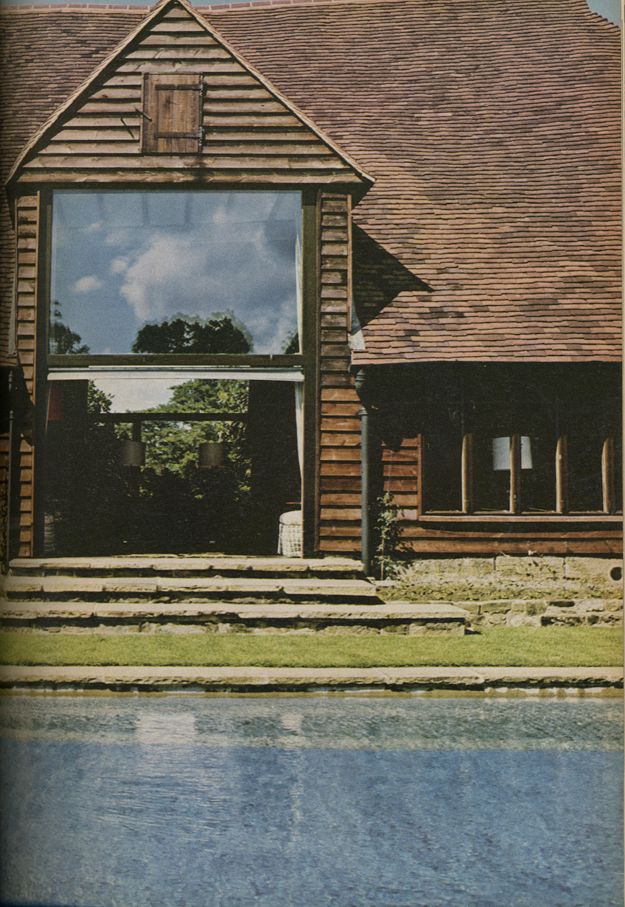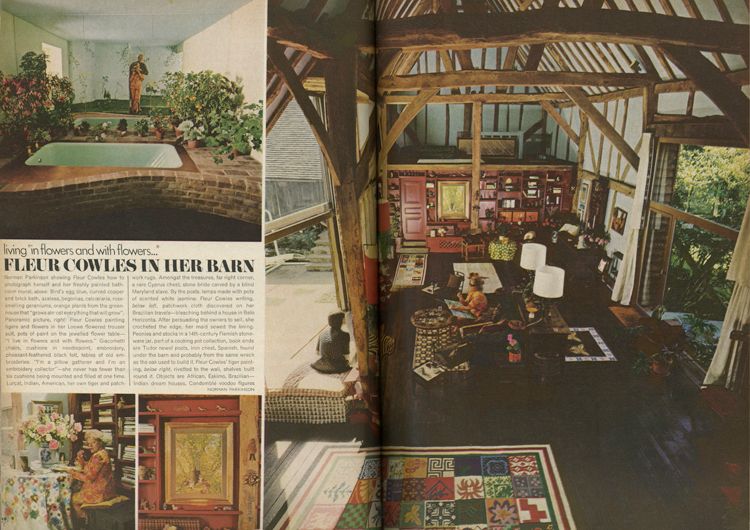
Looking at the barn, across the pool, sky mirrored in glass; electric portcullis window open. Everything looks old and simple, walls are creosoted, pool edge in old paving stones, tiled in turquoise and royal blues. Meadow turf was grown specially to blend with the old lawns, and round the pool are one hundred and sixty-two varieties of white flower, to contrast with the brilliance elsewhere.

Fifteen years ago Fleur Cowles and her husband Tom Montague Meyer bought a timbered sixteenth-century farmhouse deep in an English valley. With time, thought, care, money, they did miraculous things to it, and all the time a few yards away, facing the house, was the great tithe barn built in he same year 1572 by the same yeoman farmer with stoat oak ship's timbers salvaged from a wreck. Try as they might they could not touch it. It was scheduled as A Historic Monument. Then they met Michael Lloyd, a expert in such matters who knew how the system worked, and eighteen months ago got permission to save the barn from collapse...
They dismantled the barn piece by piece, numbered each beam and tile, repaired or replaced them with material of the same age, keeping irregularities... They considered each item, changed what wasn't perfect, and the finished job shows extraordinary patience an eye for detail - decorative and invisible.Concrete, iron and steel are now an integral part of the structure, it can survive anything but a direct bomb hit. Fleur Cowles feels they have given something back to England.
Stitched lovingly together again the barn stands three-sided round a swimming-pool. After the low beamed ceilings of the main house, the great hall seems as big as a church, light pouring in from vast windows either side, roof going up and up. Walls between the beams are pale blue plaster and plaster-board, the woodwork for shelves and stairs deep plum red. There are galleries either end- one for music, one for a hammock where people can swing and hear exquisite sounds float over from the other side. Under one gallery is a bedroom, not really for use, with velvet ribboned curtains, ribbon painting, a complete 1840 American collection of scissor pictures, a curved bathroom with mural painted by Fleur Cowles. The other wing has kitchen, bathroom, sauna, and changing rooms, one a teak boiserie for women, Focal point in the main hall is a life-size bronze of a girl by Sydney Harpley Fleur Cowles discovered him at the RCA in 1951, and has been collecting him ever since. Most furniture is pre-Commonwealth and there is a great Brazilian collection - Gennaro's finely delineated townscapes, Indian paintings, a confessional chair, talisman from the voodoo-Catholic Condomble region of the Bahia province, Carybe's carved jacaranda wood goddess of the sea inlaid with huge precious stones.
Fleur Cowles is a collector of collections, of innocent bright beautiful things made at all times, in all countries. She is also writer, amateur painter and professional patron of the arts, particularly the decorative ones. She and her friends and staff are always on the look out for people who can make the things she likes. She cajoles artists and has the way she sees things translated into every sort of object. Here in the barn her tree drawings became tree lamps made in iron by a blacksmith, even the bark texture was an exact replica. One flower painting became a round table set with semi-precious stones by a man in Northern Brazil, another a tapestry cushion stitched by her butler. Her maid crocheted a daisy tablecloth. Flowers are everywhere. She is the kind of person who always carries a plastic bag for cuttings. The kind who hates decorated food but plants a flower in the middle of a pudding to go with the tablecloth (the pudding would be quite delicious). She designed a patchwork, cut out and painted a brown paper tigerskin, and craftsmen in the Estra Madura in Spain made them into rugs. She has houses all over the world filled with amazing numbers of amazing things; you'd think it would make her dizzy but she knows exactly what's what - whether it's her cottage in Cornwall, her set in Albany, her castle in Spain, "two flawless towers amongst ruins, a very liveable small castle" that is getting the full Fleur Cowles treatment supervised by the Prado architect.
Her genius is for the small details of living, her life is complex, well-ordered simplicity. Down on the farm there are "hogs, hens, milk and cream from neighbouring farmers," enough flowers to take up to town, peace. She can put her mind to a hundred things one after the other, switch from painting to talking to writing to ordering tea. When you sit back on smoky suede and needlepoint to sip the tea, smelling the jasmine, looking past Giacometti chairs, the flower-jewelled table and blue-tiled pool to an arc of rosy rhododendrons flowering over the copper beech hedge, it all seems a perfectly happy accident.
Photos by Norman Parkinson and text by Antonia Williams for Vogue UK, October 1971.